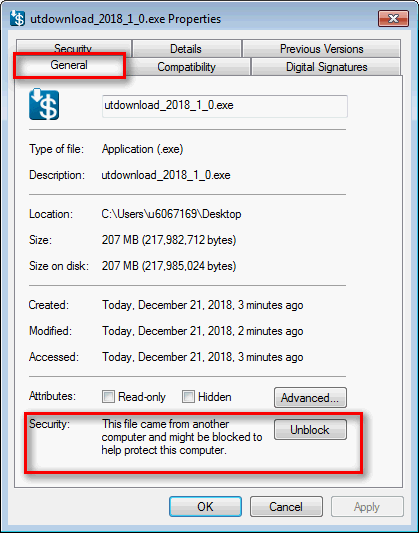Scenario
You might see these errors during the desktop setup for UltraTax CS or Fixed Assets CS.
Error messages
Windows cannot find desktop_ut.msi make sure the name is typed correctly and try again
Windows cannot find desktop_fa.msi make sure the name is typed correctly and try again
Causes
These errors can be caused by a blocked installer or by Windows permissions issues.
Solutions
Unblock the installation file
Executable files that are downloaded to install an application can be automatically blocked by the workstation, which can result in the errors discussed in this article. To unblock a file, follow these steps:
- Locate the file used to install the application.
- Right-click on the file and choose Properties.
- In the General tab, locate the Unblock button. If there is not an Unblock button, this file is not blocked in this manner. If the button is present, click it, click Apply, then OK. Show me.
- Rename the UT or DSW folder and reinstall.
Permissions
Ask your IT professional or network administrator to review the Permissions guidelines for the CS Professional Suite.
In addition to setting folder permissions, you may also need to run the installer using the system account vs. the domain admin account.
- If you are experiencing failure installing to a network drive please first collect the logs referenced in the installer logging and obtain them for development.
- Download PsExec from Microsoft's website.
- Extract the .zip file to a folder location on the user’s pc or Network. You want them extracted to the machine that will be running the UltraTax CS and/or Fixed Assets CS installer.
- Open the Command Prompt as Admin by going to Start > Accessories and right clicking on Command Prompt and click Run As Administrator on the machine where you will be running the install from.
- Type psexec -i -s cmd.exe and press Enter.
- Type net use X: \\ComputerName\ShareName, where x-the network drive letter you want to map.
Was this article helpful?
Thank you for the feedback!




